 Following the controversary over the sale of tickets for popular live events such as Taylor Swift’s Eras tour and the Oasis Live ’25 Tour, the government launched a consultation exercise in January 2025 on the resale of tickets. Titled, ‘putting fans first’, the exercise sought the views of individuals and organisations on a range of policy proposals. One of these was the implementation of a cap on the resale price of tickets.
Following the controversary over the sale of tickets for popular live events such as Taylor Swift’s Eras tour and the Oasis Live ’25 Tour, the government launched a consultation exercise in January 2025 on the resale of tickets. Titled, ‘putting fans first’, the exercise sought the views of individuals and organisations on a range of policy proposals. One of these was the implementation of a cap on the resale price of tickets.
The government is not only considering whether to implement a cap but also the level at which it might be set. The following question was included in the consultation exercise.
What is the maximum uplift that you think should be applied if ticket resales were to be subject to a price cap? Please state the reason for your selection.
• no uplift at all
• 10% or less
• between 10 and 20%
• between 20 and 30%
• other – please state
Some platforms such as Twickets and Ticketswap already cap resale prices on their platforms at between 5 and 10 per cent above the face value of the ticket. They are, therefore, less likely to be affected by any new price regulation unless the ‘no uplift at all’ option is chosen. On other platforms, such as Viagogo and Stubhub, resellers are free to list tickets at whatever price they choose. This is often referred to as the uncapped market, and tickets for the Oasis tour with a face value of £150 were listed on these websites for £14 000. The implementation of a price cap is likely to have a big impact on this part of the resale market. The chief executive of StubHub stated in June 2025 that the business would probably have to exit the UK if a cap was introduced.
 Although many fans dislike the uncapped secondary ticketing market, most economists take a more positive view. They see them as a way of facilitating mutually beneficial trade and helping to reallocate tickets to those with the highest willingness to pay. This reduces levels of allocative inefficiency/deadweight welfare loss in the market.
Although many fans dislike the uncapped secondary ticketing market, most economists take a more positive view. They see them as a way of facilitating mutually beneficial trade and helping to reallocate tickets to those with the highest willingness to pay. This reduces levels of allocative inefficiency/deadweight welfare loss in the market.
Economists also tend to argue against the use of price controls in competitive markets because of their negative impact on supply. If price controls reduce the available returns to sellers, they have an incentive to do something else with their time/resources i.e. switch to supplying other goods and services in markets not subject to price controls. This reduces supply in the regulated market and so could have a negative impact on consumer surplus.
What are the issues with the secondary market?
 Given the benefits outlined by economists of having an uncapped secondary ticketing, why is the government considering the implementation of a price cap? One potential issue of having an uncapped secondary ticketing market is that developments in technology make it easier for professional resellers to buy very large quantities of tickets. This makes it increasingly difficult for fans who want to attend the event from being able to purchase a ticket.
Given the benefits outlined by economists of having an uncapped secondary ticketing, why is the government considering the implementation of a price cap? One potential issue of having an uncapped secondary ticketing market is that developments in technology make it easier for professional resellers to buy very large quantities of tickets. This makes it increasingly difficult for fans who want to attend the event from being able to purchase a ticket.
Reports also suggest that professional resellers use illegal methods to both mass purchase and resell tickets. For example, to overcome any limits on sales imposed by the sellers in the primary market, some use automated software, fake IDs and multiple credit cards. Two people convicted of fraudulent trading in 2024 were found to have bought 47 000 tickets over a 212-year period, using 127 names and 187 different e-mail addresses.
Some resellers have also acted in ways that do not comply with consumer law when advertising tickets for sale. For example, not providing information such as the ticket number and other details about where the seat is located i.e. the block/area and row.
These rent seeking activities by professional resellers could outweigh the positive impact of uncapped secondary market on allocative efficiency.
Implementing a resale price cap would reduce the incentives for professional resellers to purchase large quantities of tickets and engage in these rent-seeking activities. However, in the consultation document the government recognises that the implementation of a resale price cap would be a ‘significant and complex intervention’.
An important implementation issue
To calculate the resale price cap for any live event, the original price of the ticket in the primary market needs to be known. This raises an interesting question – should the cap apply to the initial face value of the ticket or the total price the customer pays?
The face value of the ticket may only represent a proportion of the actual cost of buying a ticket because of the widespread use of drip pricing. This is the practice of applying additional fees as the consumer proceeds through the online purchasing process. These fees can sometimes add around 25 per cent and more to the price of a ticket. In the consultation document, the government suggested that the cap should apply to the face value of the ticket plus all compulsory fees.
 One issue raised in the response to the consultation by the Competition and Markets Authority is that these fees are not always made clear by sellers in the primary market in a clear and transparent way. Therefore, for the policy to be effective, primary market sellers would have to make information on both ticket prices and any fees clearly and easily available. Recent changes to the law that prohibit drip pricing might help to address this issue.
One issue raised in the response to the consultation by the Competition and Markets Authority is that these fees are not always made clear by sellers in the primary market in a clear and transparent way. Therefore, for the policy to be effective, primary market sellers would have to make information on both ticket prices and any fees clearly and easily available. Recent changes to the law that prohibit drip pricing might help to address this issue.
The potential impact of a resale price cap on fraud
 To avoid the price cap, there is a danger that increasing numbers of buyers and sellers stop using capped secondary ticket platforms, where activity is easier to observe/regulate, and switch to other non-specialist platforms where detection of illegal behaviour and enforcement of consumer law is more difficult. Examples of non-specialist platforms where sales might increasingly take place include Facebook Marketplace, Instagram Shop, X (formerly Twitter) and internet forums. With lower levels of consumer protection and the greater difficulty of detecting illegal behaviour, sales via these non-specialist platforms are more vulnerable to scams and fraud.
To avoid the price cap, there is a danger that increasing numbers of buyers and sellers stop using capped secondary ticket platforms, where activity is easier to observe/regulate, and switch to other non-specialist platforms where detection of illegal behaviour and enforcement of consumer law is more difficult. Examples of non-specialist platforms where sales might increasingly take place include Facebook Marketplace, Instagram Shop, X (formerly Twitter) and internet forums. With lower levels of consumer protection and the greater difficulty of detecting illegal behaviour, sales via these non-specialist platforms are more vulnerable to scams and fraud.
When referring to the impact of a resale price cap, the chief executive of StubHub argued that:
It will have a massive negative impact on consumers. It’s not like the demand is going to go away, it’s just going to move somewhere else, and that somewhere else is going to be the black market [where] consumers aren’t protected.
To test the hypothesis that price controls lead to greater incidences of fraud, one study used polling data to compare ticket fraud rates in the UK with Victoria, Australia and Ireland. In 2009, the state government of Victoria made it illegal for tickets to be resold for more than 10 per cent of their face, while the Irish government introduced the Sale of Ticket Act in 2021 that prohibited the resale of tickets above their original price. The study found that the proportion of respondents who reported being victims of ticket fraud over the previous two years was around four times higher in Victoria and Ireland than the UK. The most common sales channel where consumers experienced ticket fraud in all three countries were social media platforms.
Another example of the potential impact of the price cap in Ireland on fraud relates to the first ever regular-season NFL game that is being played in Dublin on 28 September 2025 between the Pittsburgh Steelers and the Minnesota Vikings. The online bank, Revolut, reported an 80 per cent increase in the number of ticket scams when tickets for this game went on sale.
In response to the consultation exercise, the Competition and Markets Authority backed the implementation of a resale price. It will be interesting to see if the government goes through with the measure in the next few months.
Consultation
Articles
Blogs on this site
Questions
- Why might event organisers set ticket prices below the market clearing rate? Illustrate the impact of setting prices below market clearing rates on consumer, producer and total surplus in the primary market for tickets.
- Using a demand and supply diagram, explain how the uncapped secondary ticket market could reduce deadweight welfare loss. Discuss any assumptions you have made about the allocation of tickets among potential buyers in the primary market (i.e. sorting).
- Is it possible for professional resellers to continue making a profit if tickets are sold at market clearing rates in the primary market? Explain your answer.
- Under what circumstances would a maximum price set below the market clearing rate in a competitive market have a negative impact on consumer surplus? Draw a diagram to illustrate your answer.
- Using examples, explain what is meant by ‘rent seeking’ in economic theory.
Outline some of the recent updates to the law on pricing information that businesses must show customers.
- What policies, other than a resale price cap, could the government introduce to try to address some of the issues with the ticketing market for live events?
 The UK energy regulator, Ofgem, has announced that the UK energy price cap will rise in October by an average of 2%. The energy price cap sets the maximum prices for electricity and gas that can be charged by suppliers to households. For those paying by direct debit, the maximum electricity price per kilowatt-hour (kWh) will rise from 25.73p to 26.35p, with the maximum daily standing charge rising from 51.37p to 53.68p. As far as gas is concerned, the maximum price per kWh will fall slightly from 6.33p to 6.29p, with the maximum daily standing charge rising from 29.82p to 34.03p. Ofgem estimates that this will mean that the capped cost to the average household will rise from £1720 to £1755.
The UK energy regulator, Ofgem, has announced that the UK energy price cap will rise in October by an average of 2%. The energy price cap sets the maximum prices for electricity and gas that can be charged by suppliers to households. For those paying by direct debit, the maximum electricity price per kilowatt-hour (kWh) will rise from 25.73p to 26.35p, with the maximum daily standing charge rising from 51.37p to 53.68p. As far as gas is concerned, the maximum price per kWh will fall slightly from 6.33p to 6.29p, with the maximum daily standing charge rising from 29.82p to 34.03p. Ofgem estimates that this will mean that the capped cost to the average household will rise from £1720 to £1755.
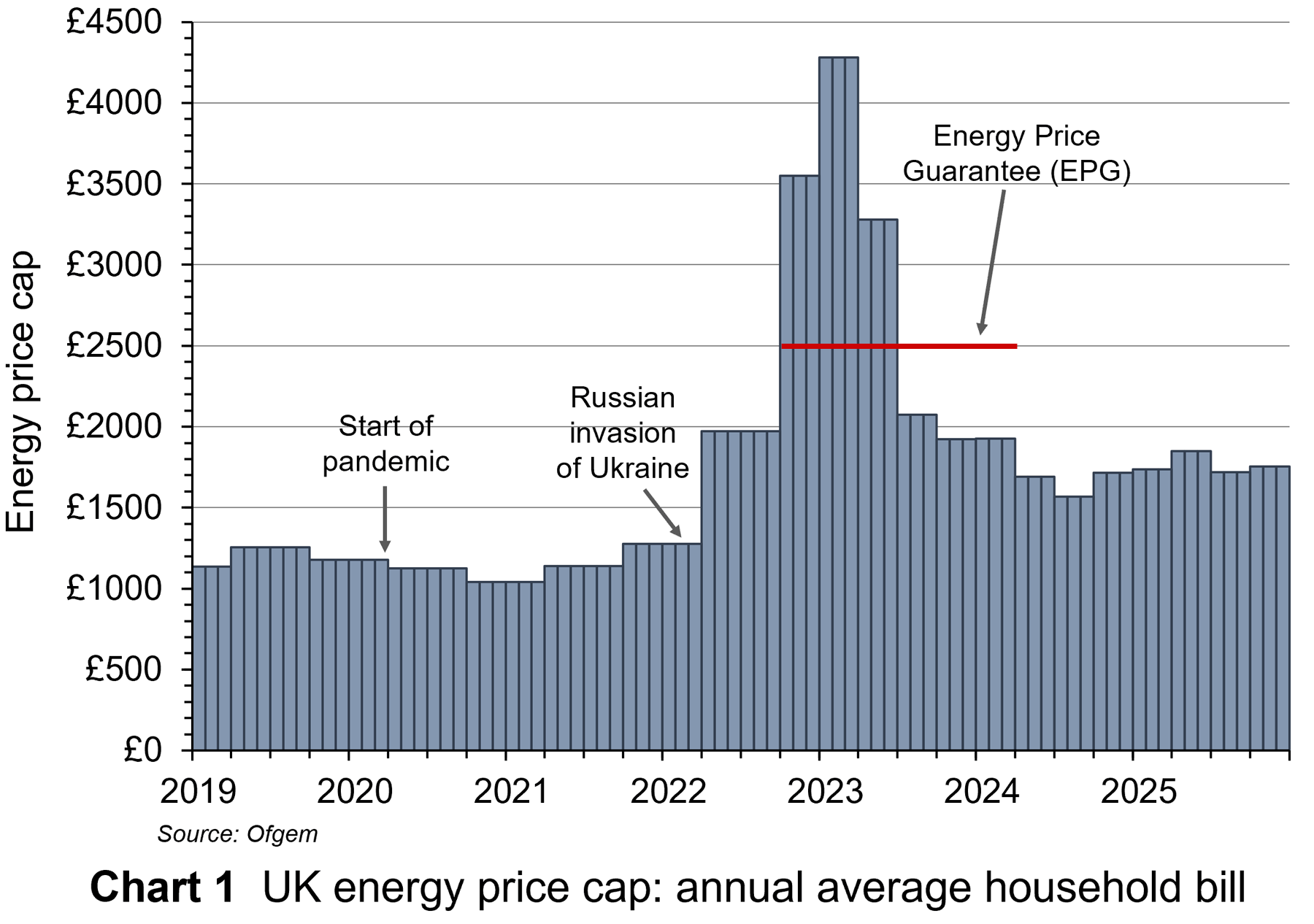 The average capped cost is now much lower than the peak of £4279 from January to March 2023. This followed the huge increase in international gas prices in the aftermath of the invasion of Ukraine and the cutting off of gas supplies from Russia. Note that although the suppliers received these capped prices, average consumers’ bills were limited to £2500 from October 2022 to March 2024 under the government’s Energy Price Guarantee scheme, with suppliers receiving a subsidy from the government to make up the shortfall. But despite today’s cap being much lower than at the peak, it is still much higher than the cap of £1277 prior to Russia’s invasion of Ukraine: see Chart 1 (click here for a PowerPoint).
The average capped cost is now much lower than the peak of £4279 from January to March 2023. This followed the huge increase in international gas prices in the aftermath of the invasion of Ukraine and the cutting off of gas supplies from Russia. Note that although the suppliers received these capped prices, average consumers’ bills were limited to £2500 from October 2022 to March 2024 under the government’s Energy Price Guarantee scheme, with suppliers receiving a subsidy from the government to make up the shortfall. But despite today’s cap being much lower than at the peak, it is still much higher than the cap of £1277 prior to Russia’s invasion of Ukraine: see Chart 1 (click here for a PowerPoint).
So is the capped price purely a reflection of the international price of gas, or is it more complicated? The picture is slightly different for gas and electricity.
Gas prices
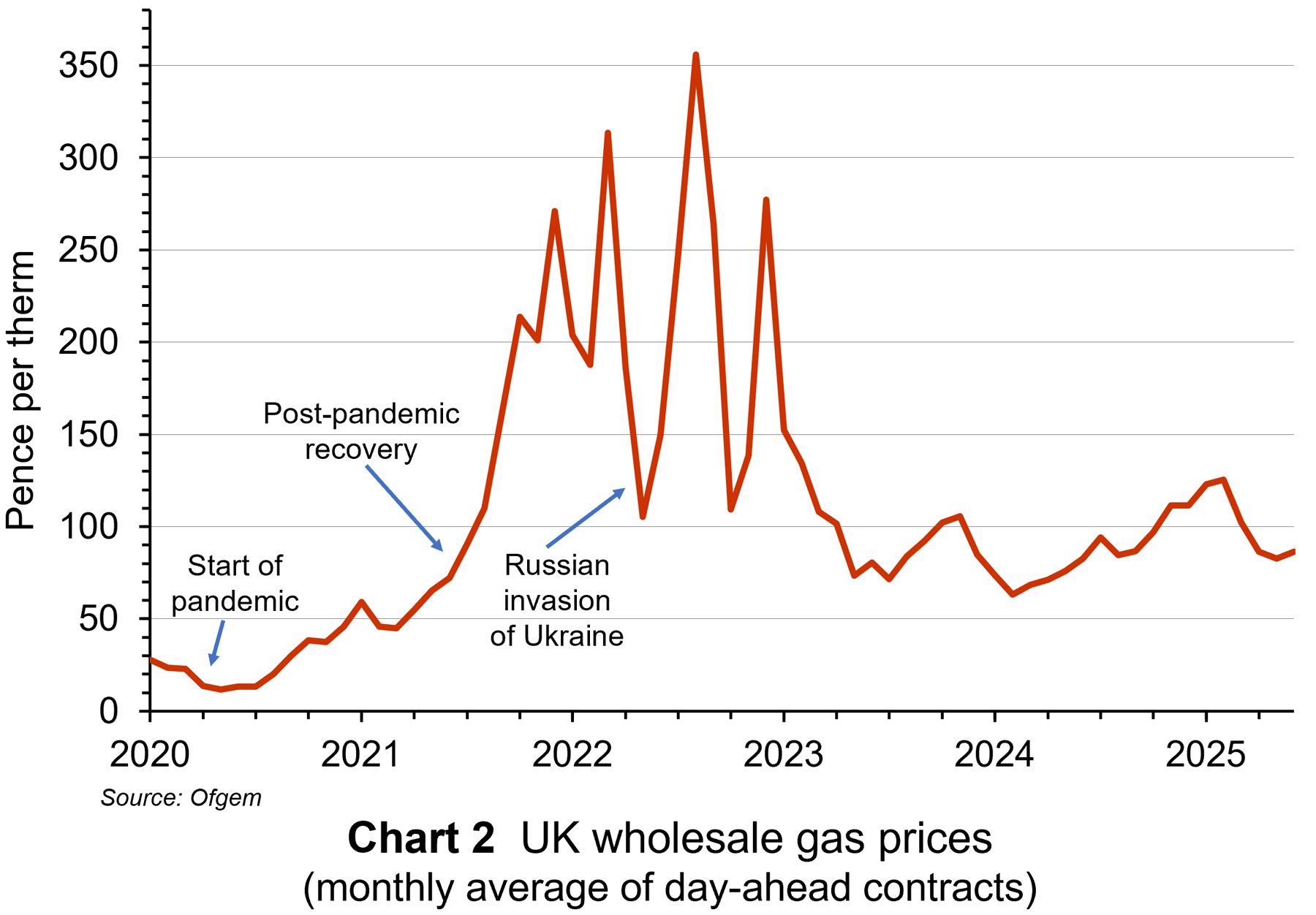 As far as gas prices are concerned, the price does largely reflect the international price: see Chart 2 (click here for a PowerPoint).
As far as gas prices are concerned, the price does largely reflect the international price: see Chart 2 (click here for a PowerPoint).
The UK is no longer self-sufficient in gas and relies in part on imported gas, with the price determined in volatile international markets. It also has low gas storage capacity compared with most other European countries. This leaves it highly reliant on volatile global markets in periods of prolonged high demand, like a cold winter. Is such cases, the UK often has to purchase more expensive liquefied natural gas (LNG) from global suppliers.
Additionally, taxes, environmental levies and the costs of the nationwide gas distribution network contribute to the overall price for consumers. Changes in these costs affect gas prices. These are itemised below in the case of electricity.
With electricity pricing, the picture is more complex.
Electricity prices
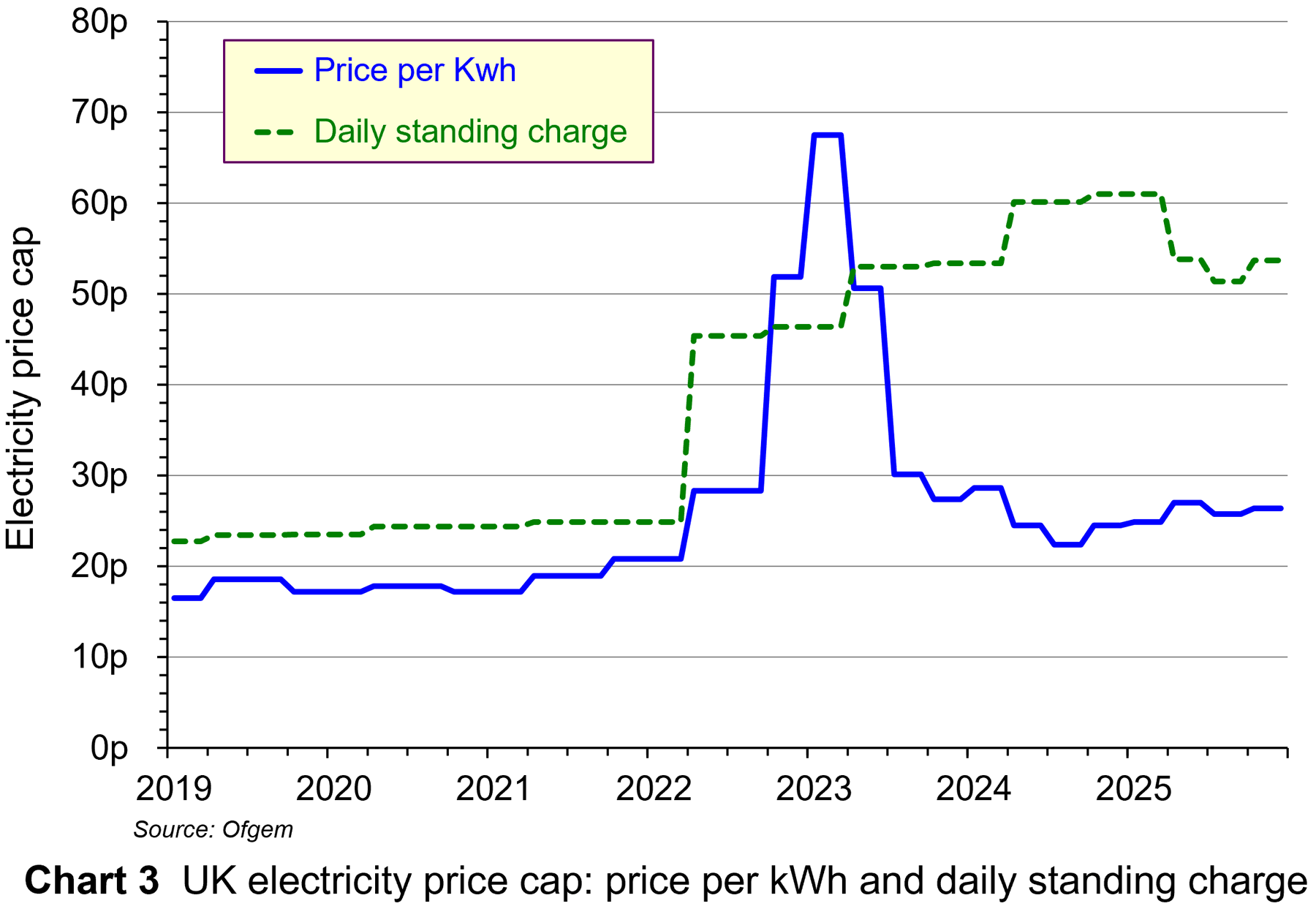 Electricity generation costs vary considerably with the different methods. Renewable sources like wind and solar have the lowest marginal costs, while natural gas plants have the highest, although gas prices fluctuate considerably.
Electricity generation costs vary considerably with the different methods. Renewable sources like wind and solar have the lowest marginal costs, while natural gas plants have the highest, although gas prices fluctuate considerably.
So how are consumer electricity prices determined? And how is the electricity price cap determined? The price cap for electricity per kWh and the daily standing charge for electricity are shown in Chart 3 (click here for a PowerPoint).
Marginal cost pricing. The wholesale price of electricity in the UK market is set by the most expensive power source needed to meet demand on a day-by-day basis. This is typically gas. This means that even when cheaper renewables (wind, solar, hydro) or nuclear power generate most of the electricity, high gas prices can increase the cost for all electricity. The wholesale price accounts for around 41% of the retail price paid by households.
 It also means that profits for low-marginal-cost producers could increase significantly when gas prices rise. To prevent such (low-carbon) suppliers making excess profits when the wholesale price is high and possibly making a loss when it is low, the actual prices that they receive is negotiated in advance and a contract is signed. These contracts are known as Contracts for Difference (CfDs). CfDs provide a fixed ‘strike price’ to low-carbon generators. The strike price is set so as to allow low-carbon generators to recoup capital costs and is thus set above the typical level of marginal cost. If the wholesale price is below the strike price, payments to generators to cover the difference are funded by amounts collected from electricity suppliers in advance using the CfD Supplier Obligation Levy. If the wholesale price is above the strike price, the difference is returned to consumers in terms of lower electricity bills.
It also means that profits for low-marginal-cost producers could increase significantly when gas prices rise. To prevent such (low-carbon) suppliers making excess profits when the wholesale price is high and possibly making a loss when it is low, the actual prices that they receive is negotiated in advance and a contract is signed. These contracts are known as Contracts for Difference (CfDs). CfDs provide a fixed ‘strike price’ to low-carbon generators. The strike price is set so as to allow low-carbon generators to recoup capital costs and is thus set above the typical level of marginal cost. If the wholesale price is below the strike price, payments to generators to cover the difference are funded by amounts collected from electricity suppliers in advance using the CfD Supplier Obligation Levy. If the wholesale price is above the strike price, the difference is returned to consumers in terms of lower electricity bills.
Policy costs. Electricity bills include an element to fund various social and environmental objectives. This element is also included in the cap. From October to December 2025, this element of the cap will be 11.3%. The money helps to subsidise low-carbon energy generation and fund energy efficiency schemes. It also funds the Warm Home Discount (WHD). In the October to December 2025 price cap, this amounted to a discount for eligible low-income and vulnerable households of £150 per annum on their electricity bills. The WHD element is included in the standing charge in the price cap. From October 2025, more generous terms will mean that the number of households receiving WHD will increase from 3.4 million to 6.1 million households. This is the main reason for the £35 increase in the cap.
Network costs. These include the cost of building, maintaining and repairing the pipes and wires that deliver gas and electricity to homes. From October to December 2025, this element of the cap will be 22.6%.
Supplier business costs. These include operating costs (billing, metering, office costs, etc.) and servicing debt. From October to December 2025, this element of the cap will be 15.4%.
Profit Allowance. A small percentage is added to the price cap for energy suppliers’ profits. This is known as the Earnings Before Interest and Tax (EBIT) allowance and is around 2.4%. This has a fixed component that does not change when the overall price cap is updated and a variable component that rises or falls with changes in the cap.
Reliance on gas, low gas storage facilities, marginal cost pricing and the commitment to invest in low-carbon electricity and home heating all add to the costs of energy in the UK, making UK electricity prices among the highest in the world.
Articles
Information and Data
Questions
- Why are the UK’s energy prices among the highest in the world?
- What are the arguments for and against subsidising wind power?
- What is the Contracts for Difference scheme in low-carbon energy. What CfDs have been awarded? Assess the desirability of the scheme.
- Is the capping of gas and electricity prices the best way of providing support for low-income and vulnerable consumers?
- How are externalities relevant in determining the optimal pricing of electricity?
 The Digital Markets Act (DMA) outlines a new regulatory approach that the European Commission (EC) is taking to address concerns over the lack of competition in digital platform markets. The DMA complements existing European Union competition law and officially came into force on 1st November 2022.
The Digital Markets Act (DMA) outlines a new regulatory approach that the European Commission (EC) is taking to address concerns over the lack of competition in digital platform markets. The DMA complements existing European Union competition law and officially came into force on 1st November 2022.
In the first stage of this new regulatory approach, the EC identified ten core platform services (CPS). Examples include search engines, online social networking services, video sharing services, cloud computing services, web browsers and operating systems. These services act as important gateways for large numbers of businesses and consumers to interact with one another. They also have some important economic characteristics, such as large economies of scale and very strong network effects.
The next stage of the regulatory process was to assess which of the large established businesses should be designated as ‘gatekeepers’ of these CPS. To be judged as a gatekeeper, a business had to meet three qualitative criteria. Using quantitative thresholds as a guide to see if these qualitative criteria had been met, the following six companies were designated as gatekeepers by the EC in September 2023: Alphabet (Google’s parent company), Amazon, Apple, ByteDance (owner of TikTok), Meta (owner of Facebook) and Microsoft. Individual companies can be gatekeeper for more than one CPS. For example, Apple was judged to be a gatekeeper for both web browsers (Safari) and operating systems (iOS and iPadOS).
Rules and compliance
 Once a business has been designated as a gatekeeper for one or more CPS, the DMA imposes a set of rules on its future conduct. Some of these rules refer to conduct that the business must follow, while others refer to types of behaviour that are prohibited. The EC sometimes refer to these rules as a list of “do’s” and “don’ts”.
Once a business has been designated as a gatekeeper for one or more CPS, the DMA imposes a set of rules on its future conduct. Some of these rules refer to conduct that the business must follow, while others refer to types of behaviour that are prohibited. The EC sometimes refer to these rules as a list of “do’s” and “don’ts”.
One of the rules refers to interoperability. This is the degree to which different (a) software, (b) devices and (c) other applications can work seamlessly together (i.e. share functionality/data) without requiring any actions by the user (i.e. how compatible they are with one another).
For example, consider the degree of interoperability between the operating system of a gatekeeper, such as Apple, and other hardware/software services. One of the requirements of the DMA is for the gatekeeper to provide the same degree of interoperability for the hardware/software services provided by rival businesses as they do for similar hardware/software services they supply. This is sometimes referred to as the interoperability obligation.
Once a business is designated as a gatekeeper, it has 6 months to submit a compliance report to the EC that demonstrates how it is meeting the rules set out in the DMA. This should include descriptions of any changes the company has had to make to its conduct to meet the new requirements. Further compliance reports must then be submitted on an annual basis.
If, after assessing a compliance report, the EC suspects that a gatekeeper is still acting in ways that do not comply with the DMA, then it can launch either a non-compliance or specification procedure.
The case of Apple
 Apple submitted its first compliance report on 7 March 2024. It was far less extensive than those completed by other designated gatekeepers and adopted a very different tone: it directly challenged the EC’s view that the DMA rules would have a positive impact on consumer welfare.
Apple submitted its first compliance report on 7 March 2024. It was far less extensive than those completed by other designated gatekeepers and adopted a very different tone: it directly challenged the EC’s view that the DMA rules would have a positive impact on consumer welfare.
In September 2024, the EC launched its first two specification proceedings that focused on Apple’s compliance with the interoperability obligation.
The first of these proceedings opened a formal discussion with Apple over the interoperability between the iPhone operating system (iOS) and connected devices such as smartwatches and headphones. The proceeding identified nine features that gave the iOS greater functional compatibility with connected devices produced by Apple than with those made by other businesses. For example:
- Only users of connected devices produced by Apple can (a) receive iOS notifications that contain images or other attachments and (b) select the iOS notifications they want to appear on the device.
- Only users of Apple’s wireless headphones have intelligent audio switching functionality that allows them to switch automatically to the device playing the most relevant audio.
- The Airdrop function, which enables users to share files wirelessly between devices, only works if they are both produced by Apple.
- Only connected devices made by Apple have the functionality for high-bandwidth data transfer from an iPhone without having to rely on network or cellular connection. This is useful for gaming and AI services.
The second specification proceeding focused on the process developed by Apple to deal with requests from other businesses that wanted to develop hardware or software services that are compatible with the iOS.
On 18th December 2024, the EC informed Apple of its preliminary specification decisions and opened a consultation exercise with other interested parties about the suitability of its proposals. Once this process was completed, the EC informed Apple of its final specification decisions on 19 March 2025.
The EC’s decisions
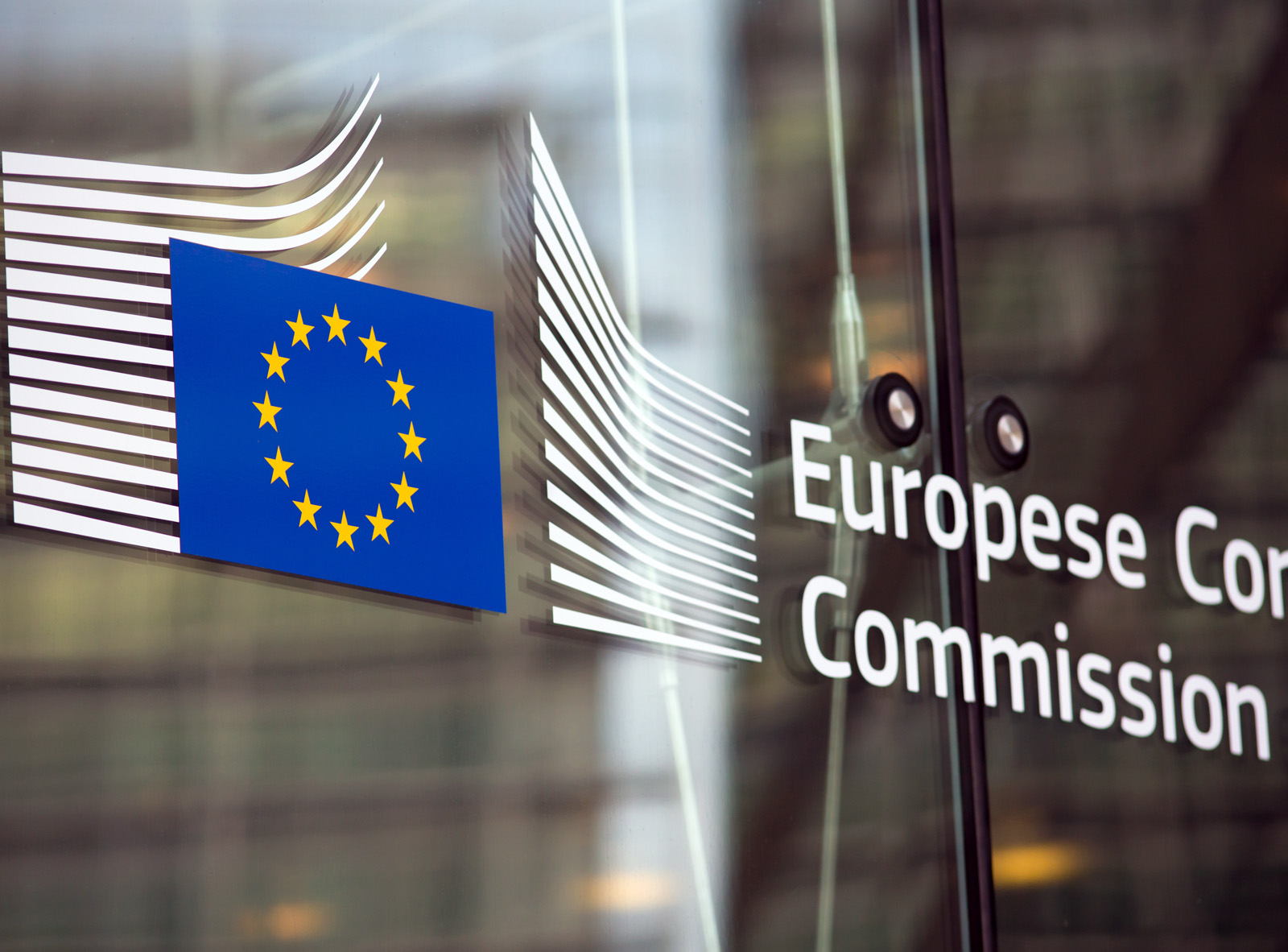 The first decision included a set of measures that Apple must take to improve the interoperability of connected devices produced by other businesses with the iOS. The EC stated that:
The first decision included a set of measures that Apple must take to improve the interoperability of connected devices produced by other businesses with the iOS. The EC stated that:
The interoperability solutions for third parties will have to be equally effective to those available to Apple and must not require more cumbersome system setting or additional user friction.
The second decision outlined measures that Apple had to take to improve the process of dealing with requests for greater compatibility with the iOS. For example, it should provide outside businesses with more (a) access to technical documentation, (b) predictable timelines for the reviews and (c) timely updates.
Apple argued that being forced to introduce these measures will (a) create significant additional costs, (b) limit its ability to develop products that work seamlessly with one another and (c) lead to its having to share sensitive customer information with its rivals.
On 30th May 2025, Apple filed an appeal against the EC’s specification decisions to the General Court of the European Union. It will be interesting to see what judgment is made on this case by the General Court and the implications this has for the enforcement of the DMA.
Video
Articles
- The EU Digital Markets Act – The Holy Grail of Big Tech Regulation?
Morrison & Foerster, Andreas Grünwald, Christoph Nüßing and Theresa Oehm (19/7/22)
- Commission starts first proceedings to specify Apple’s interoperability obligations under the Digital Markets Act
EC Press Release (19/9/24)
- Apple hits out at Meta’s numerous interoperability requests
Reuters, Foo Yun Chee (19/12/24)
- 1st Anniversary of the Digital Markets Act (DMA): Lessons learned and road ahead
Hausfeld Competition Bulletin, Ann-Christin Richter and René Galle (28/3/25)
- EU accuses Google and Apple of breaking its rules, risking Trump clash
The Guardian, Rob Davies and Dan Milmo (19/3/25)
- Brussels takes action against Google and Apple despite Trump threat
Financial Times, Barbara Moens (19/3/25)
- Brussels Takes Action Against Google And Apple Despite Trump Threat
GNC (19/3/25)
- Commission provides guidance under Digital Markets Act to facilitate development of innovative products on Apple’s platforms
EC Press Release (19/3/25)
- European Commission Fines Both Apple, Meta For DMA Breaches
Silicon UK, Tom Jowitt (23/4/25)
- Apple Appeals European Commission Order on Interoperability With Competitors’ Products
PYMNTS (2/6/25)
- https://dig.watch/updates/apple-sues-european-commission-over-dma-interoperability-ruling
The Digital Watch (6/6/25)
- Meta, Apple Launch Legal Challenges to EU DMA Rulings
PYMNTS (3/6/25)
Questions
- Identifying core platform services is similar to defining relevant markets in standard competition policy but takes a more legalistic approach. Discuss some of the problems of defining a relevant market for a digital platform.
- Outline the three qualitative criteria and the quantitative thresholds that are used by the EC to designate a digital platform as a gatekeeper of a core platform service.
- Find an example of a digital platform that met the quantitative thresholds but did not meet the qualitative criteria and so was not designated as a gatekeeper.
- Find an example of a digital platform that did not meet the quantitative thresholds but did meet the qualitative criteria and so was designated as a gatekeeper.
- Interoperability is a type of conduct that is sometimes referred to as self-preferencing: i.e. behaviour by a digital platform that gives its own products/services preferential treatment over those provided by other firms that use the same platform. What other types of conduct are possible examples of self-preferencing?
- What is the difference between a non-compliance procedure and a specification procedure? Find some recent examples of non-compliance procedures that have been undertaken by the EC to enforce the DMA.
- What are the potential advantages and disadvantages for consumer welfare of the specification decisions made by the EC?
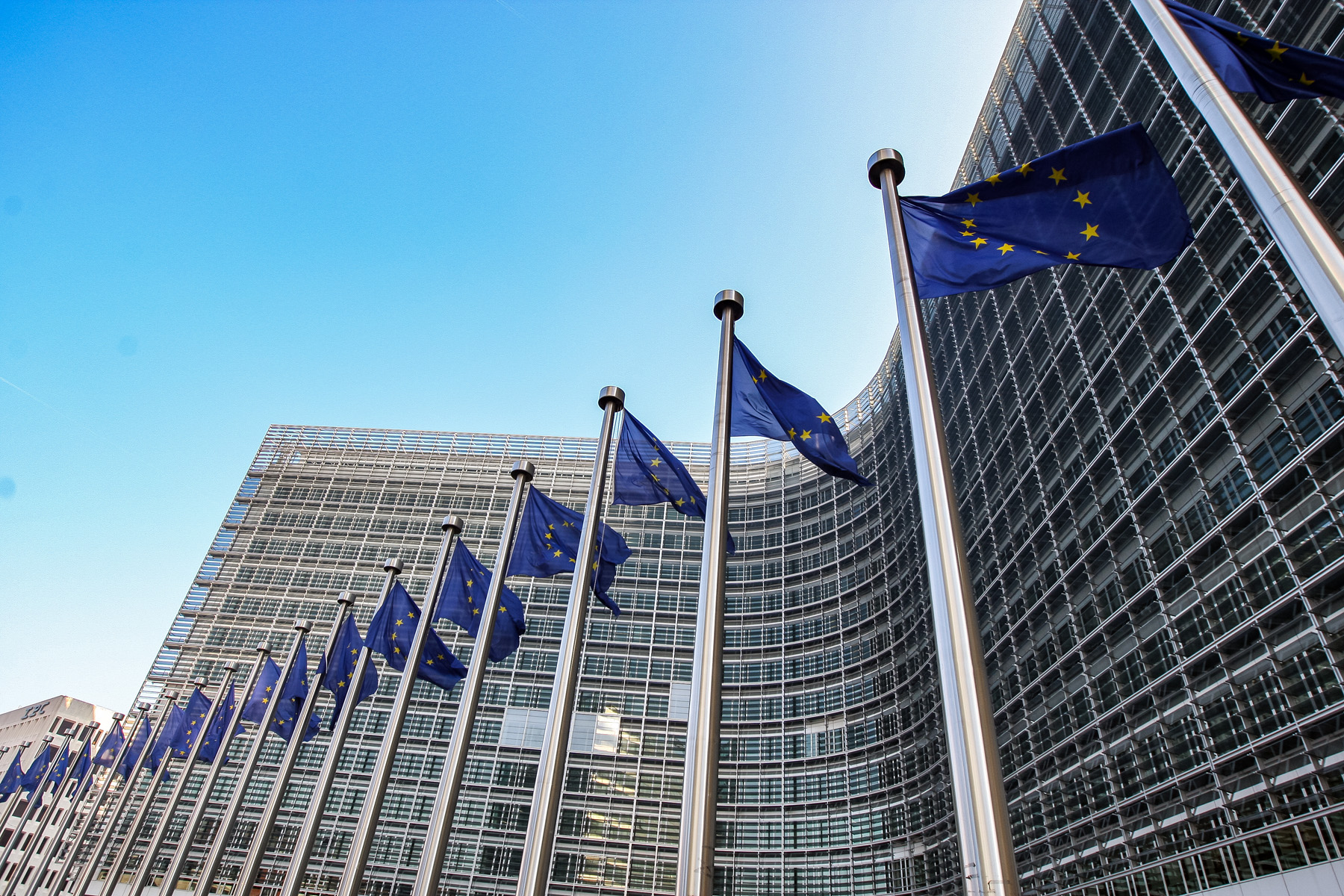 The enforcement of Article 102 of the Treaty on the Functioning of the European Union (TFEU) by the European Commission (EC) tends to focus on exclusionary abuses by firms with significant market power. Exclusionary abuses are actions that limit or prevent competition, as opposed to exploitative abuses that directly harm the consumer, such as charging high prices.
The enforcement of Article 102 of the Treaty on the Functioning of the European Union (TFEU) by the European Commission (EC) tends to focus on exclusionary abuses by firms with significant market power. Exclusionary abuses are actions that limit or prevent competition, as opposed to exploitative abuses that directly harm the consumer, such as charging high prices.
The treatment of exclusionary abuses has evolved over time. Initially, the approach towards enforcement was form-based (i.e. the nature of the abuses), but this changed when the EC produced new guidelines in 2009 which signalled a move to a more effects-based approach.
The EC plans to produce a new set of guidelines in 2025 and published a draft version in August 2024 as part of the consultation process with businesses and other stakeholders. These draft guidelines indicate a partial shift back to a form-based approach. Any moves in this direction made by the EC are likely to influence both national-level competition authorities and the courts.
The form-based approach to policy enforcement
A form-based approach to the enforcement of Article 102 assumes that certain types of business conduct are inherently anti-competitive except in very exceptional circumstances. In other words, there is a presumption that the characteristics or form of the behaviour mean that it must have a negative impact on competition and consumer welfare in virtually all real-world cases.
With a form-based approach to enforcement there is no requirement for the authorities to carry out detailed case-specific analyses of business conduct as part of an investigation. This had been the approach adopted by the EC before 2009. It is possible, however, that the same form of business conduct could have anti-competitive effects in some market situations but pro-competitive effects in others. The EC was criticised for not making enough allowance for the chances of this happening.
The effects-based approach to policy enforcement
 In response to this criticism the European Union published a new set of guidelines in 2009 which signalled that the enforcement of Article 102 was moving to a more effects-based approach. The effects-based approach uses economic analysis to assess the impact of a dominant firm’s conduct on a case-by-case basis. Context-specific evidence is examined by the competition authorities to see if the behaviour effectively excludes rival businesses from the market that are just as efficient as the dominant firm.
In response to this criticism the European Union published a new set of guidelines in 2009 which signalled that the enforcement of Article 102 was moving to a more effects-based approach. The effects-based approach uses economic analysis to assess the impact of a dominant firm’s conduct on a case-by-case basis. Context-specific evidence is examined by the competition authorities to see if the behaviour effectively excludes rival businesses from the market that are just as efficient as the dominant firm.
The use of economics in this effects-based approach gradually increased over time. Initially, the analysis was predominately based on theoretical arguments, but increasingly cases included sophisticated analysis of market-specific evidence using econometric models and market simulations. This, however, led to the following issues.
- The increasing use of complex economic analysis makes it more difficult to meet the evidentiary standards of the courts and prove a case. As the effects-based approach places a greater burden on the competition authorities to meet these evidentiary standards (i.e. provide evidence of case-specific anti-competitive effects of the conduct) it disproportionality affects their ability to prove cases.
- Businesses with significant market power are more likely to make large profits and so have access to greater resources than government-funded competition authorities. Therefore, they will be able to employ more economic consultants with the relevant technical expertise to (a) carry out the analysis and (b) communicate the findings effectively in a court case
This led to concerns that the competition authorities were losing cases where there was strong evidence of exclusionary conduct by the dominant firm.
In response to these concerns, the EC announced in 2023 that it would be revising its 2009 guidelines to improve enforcement of Article 102.
The draft guidelines
The draft guidelines published in August 2024 split different types of potentially anti-competitive conduct by dominant firms into three categories.
The first category includes types of conduct where there is a strong presumption of anti-competitive effects: i.e. the sole purpose of the business behaviour is to restrict competition. These types of conduct are referred to as a ‘naked restriction’ and the documentation provides the following three examples:
- making payments to customers (typically other businesses) on the condition that they cancel or postpone the launch of a product that uses inputs produced by the dominant firm’s rivals;
- threatening to withdraw discounts offered to suppliers unless they agree to supply the dominant firm’s product in place of a similar product produced by a rival firm;
- actively dismantling infrastructure used by a rival firm.
The guidelines indicate a form-based approach will be taken when investigating these types of conduct as the EC will not have to provide any case-specific evidence of anti-competitive effects. A business under investigation can challenge the presumption of anti-competitive effects with appropriate evidence, but the guidelines make it clear that this would only succeed in exceptional circumstances. In other words, it is highly unlikely that the conduct could ever be justified on pro-competitive grounds.
 The second category of anti-competitive conduct includes actions that are also presumed to have a negative impact on competition. The presumption, however, is not as strong as with naked restrictions, so firms have a better chance of proving pro-competitive effects.
The second category of anti-competitive conduct includes actions that are also presumed to have a negative impact on competition. The presumption, however, is not as strong as with naked restrictions, so firms have a better chance of proving pro-competitive effects.
There is a form-based element towards this second category of conduct as the EC will not have to provide any initial case specific evidence of anti-competitive effects. But, if a business under investigation does submit evidence to challenge the presumption of anti-competitive effects, the EC must demonstrate that (a) it has fully assessed this evidence and (b) the evidence is insufficient to prove that the conduct does have pro-competitive effects. As part of this process, the EC can provide its own case-specific evidence. Therefore, for this second category of conduct, the initial burden of proof effectively shifts from the competition authority to the firm under investigation, making it more of a form-based approach. However, if the firm uses relevant evidence to appeal its case, the burden shifts back to the competition authority and becomes a more effects-based approach.
The third category includes types of conduct where the EC must initially provide case-specific evidence that it reduces competition. For this category of conduct, the approach towards enforcement remains the same as in the 2009 guidelines and an effects-based approach is adopted.
It will be interesting to see the extent to which the final guidelines (a) follow the approach outlined in the draft guidance and (b) influence the enforcement of Article 102 by the EC and other national-level competition authorities.
Articles
Questions
- What exactly does it mean if a firm has ‘significant’ market power?
- What methods do competitions authorities use to assess whether a firm has a dominant market position?
- Explain the difference between conduct by dominant firm that is (a) an exploitative abuse of its market power and (b) an exclusionary abuse of its market power.
- Explain why a form-based approach towards the enforcement of competition policy is more likely to lead to Type 1 errors (false positives), whereas an effects-based approach is more likely to lead to Type 2 errors (false negatives).
- Provide some examples of exclusionary abuses that are not considered to be naked restrictions.
- Competition policy guidance documents commonly refer to ‘competition on the merits’. What is the precise meaning of this term?
 The debate about a minimum price for alcohol continues to be prompted by concerns over high levels of drinking, its effect on public health and public order, and a widespread belief that most of the alcohol that contributes to drunken behaviour is irresponsibly priced and sold. Minimum pricing for alcohol, although considered a radical intervention, is not a new policy. A minimum unit price (MUP) for alcohol was introduced in Scotland in 2018, in Wales in 2020, in the Republic of Ireland in 2022 and looks likely to be introduced in Northern Ireland.
The debate about a minimum price for alcohol continues to be prompted by concerns over high levels of drinking, its effect on public health and public order, and a widespread belief that most of the alcohol that contributes to drunken behaviour is irresponsibly priced and sold. Minimum pricing for alcohol, although considered a radical intervention, is not a new policy. A minimum unit price (MUP) for alcohol was introduced in Scotland in 2018, in Wales in 2020, in the Republic of Ireland in 2022 and looks likely to be introduced in Northern Ireland.
Despite more countries following Scotland’s lead, there are no current plans to consider an application of an MUP in England. However, with recent increases in the MUP in Scotland and the findings of a five-year review in Wales, it would suggest that this policy will continue to be at the forefront of discussions of how to tackle impacts of alcohol consumption.
Reasons and options for intervention
The main goal of introducing a minimum unit price for alcohol is to tackle unwanted consequences from the consumption of alcohol. While many people consume alcoholic drinks safely without any problems, some patterns of alcohol use are associated with significant physical, mental and social harm.
It costs UK society more than £27 billion a year through a combination of health, crime, workplace and social welfare costs. Therefore, some governments in the British Isles have deemed it necessary to intervene in this market to reduce alcohol-related harm and protect the health of those regularly drinking more than the recommended 14 units per week.
 Research has shown that making alcohol less affordable can reduce consumption and hence related harms. The World Health Organization considers minimum pricing one of its ‘best buys’ for tackling harmful alcohol use.
Research has shown that making alcohol less affordable can reduce consumption and hence related harms. The World Health Organization considers minimum pricing one of its ‘best buys’ for tackling harmful alcohol use.
There are three main policy options that aim to reduce the consumption of alcohol by making alcohol less affordable. One is to tax alcoholic drinks; the second is to set a minimum price per unit of alcohol; the third is to ban the sale of alcohol drinks below cost price (the level of alcohol duty plus VAT).
The policy option of an MUP has been adopted by Scotland, Wales and the Republic of Ireland; England has opted to use a ban on selling alcohol below the level of alcohol duty plus VAT (since 28 May 2014).
What is a minimum price?
The introduction by the government of a minimum price for a product means that it cannot legally be sold below that price. It can be set in order to achieve certain economic or social objectives that are not currently being achieved at equilibrium in the market. In order for the policy to have an effect, the minimum price must be set above the equilibrium price. This price floor then prevents prices from falling too low and settling back at equilibrium below the MUP.
A common misconception is that introducing a minimum price for alcohol is a form of taxation. However, this is not the case. Implementing an MUP means that any extra money from higher prices goes to the retailers and producers, not to the government.
Why choose a minimum price floor?
The policy has two main objectives. The first is to protect the interests of drinkers who may make poor decisions on their own behalf. This may be from lack of information, social pressures or a disregard for their own long-term health or welfare.
The second objective is to reduce the external costs placed on health services, the police, the criminal justice system, on fellow citizens or employers. There are also longer-term external costs when alcohol abuse impacts on productivity or leads to repeated absences from work.
It is argued that MUP intervention can encourage positive changes in behaviour of both consumers and producers. It can target harmful excessive drinking, while leaving the more moderate drinker relatively unaffected.
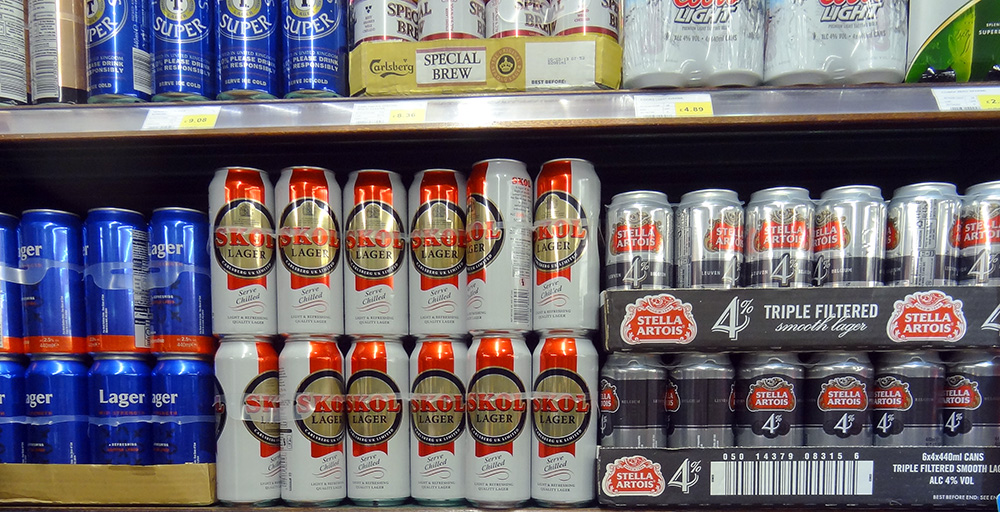 A positive impact on consumers is the possible changes in demand. People who previously consumed cheap, and often strong, drinks, such as cheap cider, will find that their marginal private cost of consuming alcohol has increased. Depending on the price elasticity of demand, their consumption will decrease and there will be a reduction in alcohol-related violence and other external costs. A positive impact on producers is that it can encourage drinks manufacturers themselves to reduce the alcohol content of their products and, therefore, limit any increase in price passed on to the consumer.
A positive impact on consumers is the possible changes in demand. People who previously consumed cheap, and often strong, drinks, such as cheap cider, will find that their marginal private cost of consuming alcohol has increased. Depending on the price elasticity of demand, their consumption will decrease and there will be a reduction in alcohol-related violence and other external costs. A positive impact on producers is that it can encourage drinks manufacturers themselves to reduce the alcohol content of their products and, therefore, limit any increase in price passed on to the consumer.
How it differs in the different parts of the British Isles
While minimum alcohol pricing is in place in several countries, policies differ. In terms of the British Isles, in 2018 Scotland became the first country to introduce a national minimum price for all types of alcohol. Two years later, Wales followed suit. The Republic of Ireland introduced minimum pricing in January 2022, while Northern Ireland has been engaged in consultation on the policy for several years. The following table shows when MUP was introduced and at what rates.
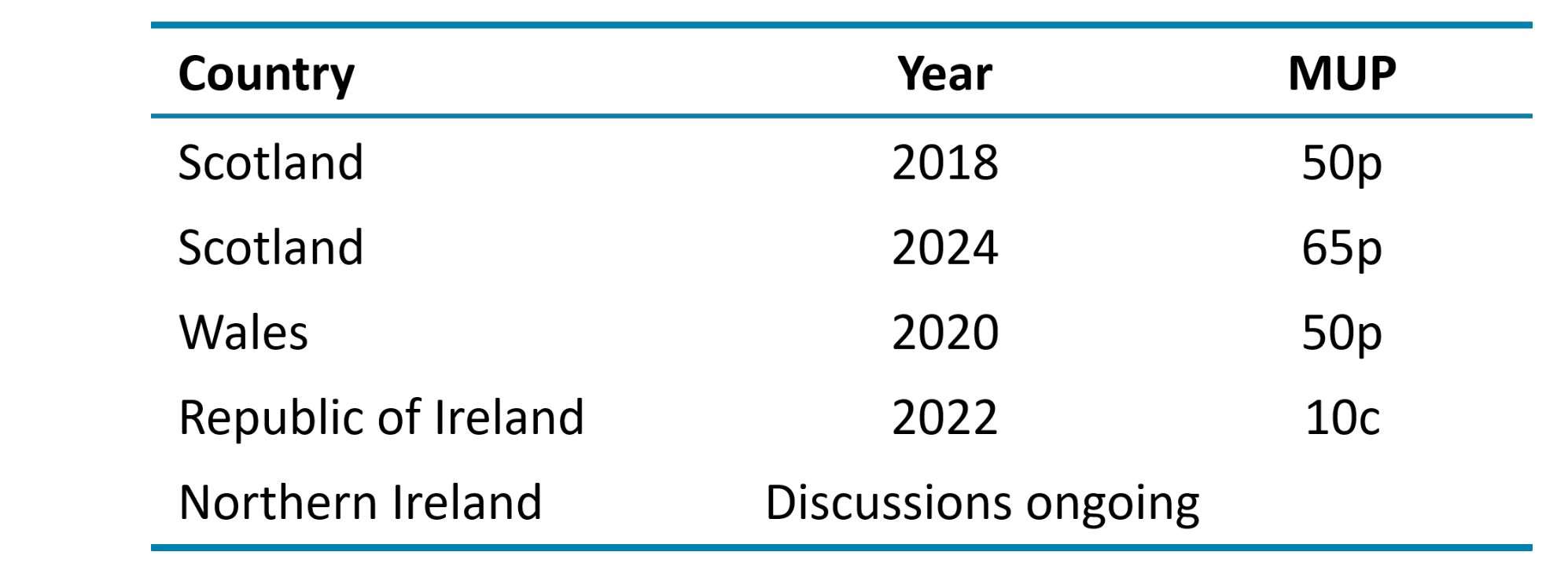
Has the MUP been effective?
Wales has reached the five-year review point since the MUP was introduced. Many of the findings within the Welsh evaluation have strong resonance with those elsewhere, particularly those of the final Scottish evaluation. There have been five main findings:
- Implementation has been smooth. Retailers have largely complied with the law, and enforcement has been effective.
- Certain cheap alcohol products have disappeared. Large bottles of strong cider, for example, are now rare. There have also been shifts in promotions and product availability.
- There are indications that overall alcohol consumption in Wales has declined. While it is difficult to measure directly, purchasing data suggests a reduction.
- Concerns about unintended consequences have not materialised significantly. Predictions of a rise in home brewing, substance switching, shoplifting and cross-border purchasing have not been widely observed.
- Some drinkers have changed their purchasing habits. A minority have switched from cider to wine or spirits as price differences narrowed. Others, particularly those on low incomes, experienced further struggles in financially maintaining their drinking habits.
There was also a study published last year (2024) in the journal Economic Inquiry, looking at the impacts of the policy during lockdown restrictions. The study showed that the introduction of MUP in Wales resulted in a 15% increase in transaction prices and a sharp reduction in the amount of alcohol bought, around 20%, with an overall drop in expenditure per customer compared to England over the same period.
However, it should be noted that the COVID pandemic disrupted drinking habits and the availability of alcohol. In addition, evaluating the overall effects of the policy has been complex with other economic factors, including the cost-of-living crisis, also influencing affordability.
Is it a fair policy?
A counter argument to applying a price intervention on alcohol is that it may have unintended private and external costs. One argument claims that young people could decide to switch to cheaper non-alcoholic drugs instead. Alternatively, they may seek to purchase alcohol on illegal shadow markets.
 Critics of the policy argue that it negatively impacts those who consume alcohol responsibly, especially families on average or below-average incomes. The wine and spirits industry tried to lobby against the Scottish government, arguing that it is inconsistent with the operation of the free market and that the intervention creates a barrier to trade. They claim that lower sales of alcoholic drinks will cost jobs in the UK, both in manufacturing and from reduced revenues of corner shops, pubs and other retailers.
Critics of the policy argue that it negatively impacts those who consume alcohol responsibly, especially families on average or below-average incomes. The wine and spirits industry tried to lobby against the Scottish government, arguing that it is inconsistent with the operation of the free market and that the intervention creates a barrier to trade. They claim that lower sales of alcoholic drinks will cost jobs in the UK, both in manufacturing and from reduced revenues of corner shops, pubs and other retailers.
There is also an argument that relying solely on an MUP targets the affordability of drinking rather than addressing all aspects of alcohol harm. Therefore, this policy is not necessarily effective in achieving all the government’s goals. Critics argue that this policy should be one component of a more comprehensive strategy delivery, which might include education, restricting the availability of alcohol, banning advertising, increasing alcohol duty, etc.
Conclusion
Although there are currently no plans to implement an MUP in England, there is ongoing pressure for the Government to consider adopting one. In the Autumn of 2024, Lord Darzi carried out an independent investigation of the NHS in England. This investigation into the NHS highlighted the ‘alarming’ death toll in England caused by cheap drink (see link below). This led public health leaders to call for action to increase the price of cheap alcohol in supermarkets and off-licences.
 However, the policy itself is not without its critics, especially those citing continued trends in actual numbers of alcohol-related deaths. Therefore, it is suggested that the policy needs to be accompanied by well-funded treatment and support services for people experiencing alcohol-related difficulties. If combined with other policy measures and social support, it has the potential to contribute significantly to reductions in alcohol-related harm.
However, the policy itself is not without its critics, especially those citing continued trends in actual numbers of alcohol-related deaths. Therefore, it is suggested that the policy needs to be accompanied by well-funded treatment and support services for people experiencing alcohol-related difficulties. If combined with other policy measures and social support, it has the potential to contribute significantly to reductions in alcohol-related harm.
Despite reservations, overall a minimum price per unit of alcohol is viewed by many as a justified intervention and is well supported by evidence. It has been accepted that a minimum price is required to reduce consumption closer towards the social optimum and in order to bring about change in consumer and producer behaviour. Given the evidence provided from current MUP countries and ongoing discussions of alcohol-related deaths in England, health officials believe a review is almost certain, even though the current government reportedly ruled out minimum unit pricing shortly after winning power.
Articles
Reports
Questions
- Using a supply and demand diagram, discuss the effect of introducing a minimum price per unit of alcohol.
- How is the price elasticity of demand for alcoholic drinks relevant to determining the success of minimum pricing?
- Compare the effects on alcohol consumption of imposing a minimum unit price of alcohol with a ban the sale of alcohol below cost price. What are the revenue implications of the two policies for the government?
- What negative externalities occur as a result in the over consumption of alcohol? How could a socially efficient price for alcohol be determined?
- Could alcohol consumption be described as a ‘de-merit good’? Explain.
- Rather than targeting the price of alcohol, what other policies could the government introduce to tackle over consumption of alcohol?
- What will determine the number of people travelling across borders within the UK (i.e. from Scotland or Wales to England) to buy cheaper alcoholic drinks?
 Following the controversary over the sale of tickets for popular live events such as Taylor Swift’s Eras tour and the Oasis Live ’25 Tour, the government launched a consultation exercise in January 2025 on the resale of tickets. Titled, ‘putting fans first’, the exercise sought the views of individuals and organisations on a range of policy proposals. One of these was the implementation of a cap on the resale price of tickets.
Following the controversary over the sale of tickets for popular live events such as Taylor Swift’s Eras tour and the Oasis Live ’25 Tour, the government launched a consultation exercise in January 2025 on the resale of tickets. Titled, ‘putting fans first’, the exercise sought the views of individuals and organisations on a range of policy proposals. One of these was the implementation of a cap on the resale price of tickets. Although many fans dislike the uncapped secondary ticketing market, most economists take a more positive view. They see them as a way of facilitating mutually beneficial trade and helping to reallocate tickets to those with the highest willingness to pay. This reduces levels of allocative inefficiency/deadweight welfare loss in the market.
Although many fans dislike the uncapped secondary ticketing market, most economists take a more positive view. They see them as a way of facilitating mutually beneficial trade and helping to reallocate tickets to those with the highest willingness to pay. This reduces levels of allocative inefficiency/deadweight welfare loss in the market. Given the benefits outlined by economists of having an uncapped secondary ticketing, why is the government considering the implementation of a price cap? One potential issue of having an uncapped secondary ticketing market is that developments in technology make it easier for professional resellers to buy very large quantities of tickets. This makes it increasingly difficult for fans who want to attend the event from being able to purchase a ticket.
Given the benefits outlined by economists of having an uncapped secondary ticketing, why is the government considering the implementation of a price cap? One potential issue of having an uncapped secondary ticketing market is that developments in technology make it easier for professional resellers to buy very large quantities of tickets. This makes it increasingly difficult for fans who want to attend the event from being able to purchase a ticket. One issue raised in the response to the consultation by the Competition and Markets Authority is that these fees are not always made clear by sellers in the primary market in a clear and transparent way. Therefore, for the policy to be effective, primary market sellers would have to make information on both ticket prices and any fees clearly and easily available. Recent changes to the law that prohibit drip pricing might help to address this issue.
One issue raised in the response to the consultation by the Competition and Markets Authority is that these fees are not always made clear by sellers in the primary market in a clear and transparent way. Therefore, for the policy to be effective, primary market sellers would have to make information on both ticket prices and any fees clearly and easily available. Recent changes to the law that prohibit drip pricing might help to address this issue.  To avoid the price cap, there is a danger that increasing numbers of buyers and sellers stop using capped secondary ticket platforms, where activity is easier to observe/regulate, and switch to other non-specialist platforms where detection of illegal behaviour and enforcement of consumer law is more difficult. Examples of non-specialist platforms where sales might increasingly take place include Facebook Marketplace, Instagram Shop, X (formerly Twitter) and internet forums. With lower levels of consumer protection and the greater difficulty of detecting illegal behaviour, sales via these non-specialist platforms are more vulnerable to scams and fraud.
To avoid the price cap, there is a danger that increasing numbers of buyers and sellers stop using capped secondary ticket platforms, where activity is easier to observe/regulate, and switch to other non-specialist platforms where detection of illegal behaviour and enforcement of consumer law is more difficult. Examples of non-specialist platforms where sales might increasingly take place include Facebook Marketplace, Instagram Shop, X (formerly Twitter) and internet forums. With lower levels of consumer protection and the greater difficulty of detecting illegal behaviour, sales via these non-specialist platforms are more vulnerable to scams and fraud. Scams and Scandals: the Great Ticket Rip-Off
Scams and Scandals: the Great Ticket Rip-Off The UK energy regulator, Ofgem, has announced that the UK energy price cap will rise in October by an average of 2%. The energy price cap sets the maximum prices for electricity and gas that can be charged by suppliers to households. For those paying by direct debit, the maximum electricity price per kilowatt-hour (kWh) will rise from 25.73p to 26.35p, with the maximum daily standing charge rising from 51.37p to 53.68p. As far as gas is concerned, the maximum price per kWh will fall slightly from 6.33p to 6.29p, with the maximum daily standing charge rising from 29.82p to 34.03p. Ofgem estimates that this will mean that the capped cost to the average household will rise from £1720 to £1755.
The UK energy regulator, Ofgem, has announced that the UK energy price cap will rise in October by an average of 2%. The energy price cap sets the maximum prices for electricity and gas that can be charged by suppliers to households. For those paying by direct debit, the maximum electricity price per kilowatt-hour (kWh) will rise from 25.73p to 26.35p, with the maximum daily standing charge rising from 51.37p to 53.68p. As far as gas is concerned, the maximum price per kWh will fall slightly from 6.33p to 6.29p, with the maximum daily standing charge rising from 29.82p to 34.03p. Ofgem estimates that this will mean that the capped cost to the average household will rise from £1720 to £1755. The average capped cost is now much lower than the peak of £4279 from January to March 2023. This followed the huge increase in international gas prices in the aftermath of the invasion of Ukraine and the cutting off of gas supplies from Russia. Note that although the suppliers received these capped prices, average consumers’ bills were limited to £2500 from October 2022 to March 2024 under the government’s Energy Price Guarantee scheme, with suppliers receiving a subsidy from the government to make up the shortfall. But despite today’s cap being much lower than at the peak, it is still much higher than the cap of £1277 prior to Russia’s invasion of Ukraine: see Chart 1 (click
The average capped cost is now much lower than the peak of £4279 from January to March 2023. This followed the huge increase in international gas prices in the aftermath of the invasion of Ukraine and the cutting off of gas supplies from Russia. Note that although the suppliers received these capped prices, average consumers’ bills were limited to £2500 from October 2022 to March 2024 under the government’s Energy Price Guarantee scheme, with suppliers receiving a subsidy from the government to make up the shortfall. But despite today’s cap being much lower than at the peak, it is still much higher than the cap of £1277 prior to Russia’s invasion of Ukraine: see Chart 1 (click  As far as gas prices are concerned, the price does largely reflect the international price: see Chart 2 (click
As far as gas prices are concerned, the price does largely reflect the international price: see Chart 2 (click  Electricity generation costs vary considerably with the different methods. Renewable sources like wind and solar have the lowest marginal costs, while natural gas plants have the highest, although gas prices fluctuate considerably.
Electricity generation costs vary considerably with the different methods. Renewable sources like wind and solar have the lowest marginal costs, while natural gas plants have the highest, although gas prices fluctuate considerably.  It also means that profits for low-marginal-cost producers could increase significantly when gas prices rise. To prevent such (low-carbon) suppliers making excess profits when the wholesale price is high and possibly making a loss when it is low, the actual prices that they receive is negotiated in advance and a contract is signed. These contracts are known as Contracts for Difference (CfDs). CfDs provide a fixed ‘strike price’ to low-carbon generators. The strike price is set so as to allow low-carbon generators to recoup capital costs and is thus set above the typical level of marginal cost. If the wholesale price is below the strike price, payments to generators to cover the difference are funded by amounts collected from electricity suppliers in advance using the CfD Supplier Obligation Levy. If the wholesale price is above the strike price, the difference is returned to consumers in terms of lower electricity bills.
It also means that profits for low-marginal-cost producers could increase significantly when gas prices rise. To prevent such (low-carbon) suppliers making excess profits when the wholesale price is high and possibly making a loss when it is low, the actual prices that they receive is negotiated in advance and a contract is signed. These contracts are known as Contracts for Difference (CfDs). CfDs provide a fixed ‘strike price’ to low-carbon generators. The strike price is set so as to allow low-carbon generators to recoup capital costs and is thus set above the typical level of marginal cost. If the wholesale price is below the strike price, payments to generators to cover the difference are funded by amounts collected from electricity suppliers in advance using the CfD Supplier Obligation Levy. If the wholesale price is above the strike price, the difference is returned to consumers in terms of lower electricity bills.
 The Digital Markets Act (DMA) outlines a new regulatory approach that the European Commission (EC) is taking to address concerns over the lack of competition in digital platform markets. The DMA complements existing European Union competition law and officially came into force on 1st November 2022.
The Digital Markets Act (DMA) outlines a new regulatory approach that the European Commission (EC) is taking to address concerns over the lack of competition in digital platform markets. The DMA complements existing European Union competition law and officially came into force on 1st November 2022. Once a business has been designated as a gatekeeper for one or more CPS, the DMA imposes a set of rules on its future conduct. Some of these rules refer to conduct that the business must follow, while others refer to types of behaviour that are prohibited. The EC sometimes refer to these rules as a list of “do’s” and “don’ts”.
Once a business has been designated as a gatekeeper for one or more CPS, the DMA imposes a set of rules on its future conduct. Some of these rules refer to conduct that the business must follow, while others refer to types of behaviour that are prohibited. The EC sometimes refer to these rules as a list of “do’s” and “don’ts”. Apple submitted its first compliance report on 7 March 2024. It was far less extensive than those completed by other designated gatekeepers and adopted a very different tone: it directly challenged the EC’s view that the DMA rules would have a positive impact on consumer welfare.
Apple submitted its first compliance report on 7 March 2024. It was far less extensive than those completed by other designated gatekeepers and adopted a very different tone: it directly challenged the EC’s view that the DMA rules would have a positive impact on consumer welfare. The first decision included a set of measures that Apple must take to improve the interoperability of connected devices produced by other businesses with the iOS. The EC stated that:
The first decision included a set of measures that Apple must take to improve the interoperability of connected devices produced by other businesses with the iOS. The EC stated that: The enforcement of Article 102 of the Treaty on the Functioning of the European Union (TFEU) by the European Commission (EC) tends to focus on exclusionary abuses by firms with significant market power. Exclusionary abuses are actions that limit or prevent competition, as opposed to exploitative abuses that directly harm the consumer, such as charging high prices.
The enforcement of Article 102 of the Treaty on the Functioning of the European Union (TFEU) by the European Commission (EC) tends to focus on exclusionary abuses by firms with significant market power. Exclusionary abuses are actions that limit or prevent competition, as opposed to exploitative abuses that directly harm the consumer, such as charging high prices. In response to this criticism the European Union published a new set of guidelines in 2009 which signalled that the enforcement of Article 102 was moving to a more effects-based approach. The effects-based approach uses economic analysis to assess the impact of a dominant firm’s conduct on a case-by-case basis. Context-specific evidence is examined by the competition authorities to see if the behaviour effectively excludes rival businesses from the market that are just as efficient as the dominant firm.
In response to this criticism the European Union published a new set of guidelines in 2009 which signalled that the enforcement of Article 102 was moving to a more effects-based approach. The effects-based approach uses economic analysis to assess the impact of a dominant firm’s conduct on a case-by-case basis. Context-specific evidence is examined by the competition authorities to see if the behaviour effectively excludes rival businesses from the market that are just as efficient as the dominant firm. The second category of anti-competitive conduct includes actions that are also presumed to have a negative impact on competition. The presumption, however, is not as strong as with naked restrictions, so firms have a better chance of proving pro-competitive effects.
The second category of anti-competitive conduct includes actions that are also presumed to have a negative impact on competition. The presumption, however, is not as strong as with naked restrictions, so firms have a better chance of proving pro-competitive effects.  The debate about a minimum price for alcohol continues to be prompted by concerns over high levels of drinking, its effect on public health and public order, and a widespread belief that most of the alcohol that contributes to drunken behaviour is irresponsibly priced and sold. Minimum pricing for alcohol, although considered a radical intervention, is not a new policy. A minimum unit price (MUP) for alcohol was introduced in Scotland in 2018, in Wales in 2020, in the Republic of Ireland in 2022 and looks likely to be introduced in Northern Ireland.
The debate about a minimum price for alcohol continues to be prompted by concerns over high levels of drinking, its effect on public health and public order, and a widespread belief that most of the alcohol that contributes to drunken behaviour is irresponsibly priced and sold. Minimum pricing for alcohol, although considered a radical intervention, is not a new policy. A minimum unit price (MUP) for alcohol was introduced in Scotland in 2018, in Wales in 2020, in the Republic of Ireland in 2022 and looks likely to be introduced in Northern Ireland. Research has shown that making alcohol less affordable can reduce consumption and hence related harms. The World Health Organization considers minimum pricing one of its ‘best buys’ for tackling harmful alcohol use.
Research has shown that making alcohol less affordable can reduce consumption and hence related harms. The World Health Organization considers minimum pricing one of its ‘best buys’ for tackling harmful alcohol use.  A positive impact on consumers is the possible changes in demand. People who previously consumed cheap, and often strong, drinks, such as cheap cider, will find that their marginal private cost of consuming alcohol has increased. Depending on the price elasticity of demand, their consumption will decrease and there will be a reduction in alcohol-related violence and other external costs. A positive impact on producers is that it can encourage drinks manufacturers themselves to reduce the alcohol content of their products and, therefore, limit any increase in price passed on to the consumer.
A positive impact on consumers is the possible changes in demand. People who previously consumed cheap, and often strong, drinks, such as cheap cider, will find that their marginal private cost of consuming alcohol has increased. Depending on the price elasticity of demand, their consumption will decrease and there will be a reduction in alcohol-related violence and other external costs. A positive impact on producers is that it can encourage drinks manufacturers themselves to reduce the alcohol content of their products and, therefore, limit any increase in price passed on to the consumer. 
 Critics of the policy argue that it negatively impacts those who consume alcohol responsibly, especially families on average or below-average incomes. The wine and spirits industry tried to lobby against the Scottish government, arguing that it is inconsistent with the operation of the free market and that the intervention creates a barrier to trade. They claim that lower sales of alcoholic drinks will cost jobs in the UK, both in manufacturing and from reduced revenues of corner shops, pubs and other retailers.
Critics of the policy argue that it negatively impacts those who consume alcohol responsibly, especially families on average or below-average incomes. The wine and spirits industry tried to lobby against the Scottish government, arguing that it is inconsistent with the operation of the free market and that the intervention creates a barrier to trade. They claim that lower sales of alcoholic drinks will cost jobs in the UK, both in manufacturing and from reduced revenues of corner shops, pubs and other retailers. However, the policy itself is not without its critics, especially those citing continued trends in actual numbers of alcohol-related deaths. Therefore, it is suggested that the policy needs to be accompanied by well-funded treatment and support services for people experiencing alcohol-related difficulties. If combined with other policy measures and social support, it has the potential to contribute significantly to reductions in alcohol-related harm.
However, the policy itself is not without its critics, especially those citing continued trends in actual numbers of alcohol-related deaths. Therefore, it is suggested that the policy needs to be accompanied by well-funded treatment and support services for people experiencing alcohol-related difficulties. If combined with other policy measures and social support, it has the potential to contribute significantly to reductions in alcohol-related harm.